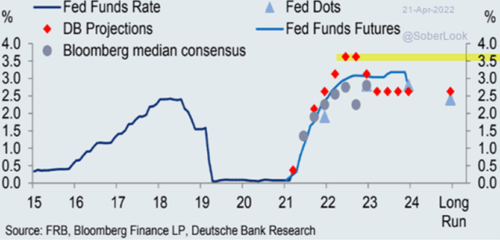What Happens to RIA EBITDA Multiples When Interest Rates Rise?
2021 may be remembered as both the busiest M&A year in history for the investment management industry, as well as the year in which valuation multiples in the space peaked. Transaction volume surged last year and carried into the first quarter, as deals negotiated during a period of cheap money, strong multiples, and the threat of changes in tax law drew both buyers and sellers to the negotiating table. Between Thanksgiving and New Year’s, however, we began to detect a change in the atmosphere for RIA valuations that, in hindsight, may prove to have been a turning point. It was around the same time that the topics of inflation and interest rates began to dominate the financial press, and it’s no coincidence. With the Fed in tightening mode, it’s time to question what impact the change in market conditions has for the investment management space.
Many industry observers believe anticipated rate hikes will have little or no impact on the sector since most RIAs don’t have any debt on their balance sheets. While it’s true that most investment management firms do not employ leverage in their capital structure, rising rates will nonetheless have an impact on their cost of equity and, consequently, their valuations. We can illustrate this by way of a common decomposition of the most prevalent valuation metric in the RIA space, the EBITDA multiple.
In the interest of simplicity, and to avoid trying to show side-by-side discounted cash flow models, we’ll use the EBITDA single period income capitalization method. We won’t dwell on every detail, but you can read more about it in a related article on our website.
This method uses the capital asset pricing model (CAPM) to develop EBITDA multiples based on a company’s risk/growth profile, interest rate levels, and historical returns on publicly traded stocks. We’ve incorporated it here to determine what happens to EBITDA multiples when interest rates go up. This methodology is especially useful to the RIA industry because EBITDA is the most cited performance metric since AUM and revenue rules of thumb tend to vary with profitability. Further, EBITDA is usually a good proxy for cash flow when capital expenditures and interest payments are minimal.
In the first example, we’ll demonstrate the impact of a 250 basis point increase in interest rates on EBITDA multiples for RIAs with no debt in their capital structure. We’ve assumed this increase based on an expected 2.5% increase in the Fed Funds Rate from the end of last year to the beginning of 2023 (year-ends depicted on the X-axis below). (Some are now anticipating a 300 bps increase.)

A sample build-up in the cost of capital for an RIA might look something like the illustration below. The cost of equity is the sum of expected equity returns in excess of long-dated treasuries, plus a non-systemic, or company specific, risk premium. The cost of debt is typical of covenant-light loans from non-bank lenders to the space, set at a premium to some base rate, illustrated here as Libor. Most RIAs operate without debt, so the weighted average cost of capital, or WACC, is the same as the cost of equity. If you subtract expected growth in cash flow from the WACC, you’re left with a capitalization rate (the inverse of which is a multiple) applicable to debt-free net income. This can be grossed up by the firm’s effective tax rate to derive an EBIT multiple, and further adjusted for depreciation to derive an EBITDA multiple. In this case, the implied EBITDA multiple is one that would be familiar to many industry participants.

Of course, this illustration derives an implied EBITDA multiple prior to expected increases in interest rates. As noted below, a 2.5% increase in the federal funds rate (which we’re using to approximate changes in the risk-free rate here) results in a 25% decrease in the EBITDA multiple (holding everything else constant) even though we’ve assumed no interest-bearing debt in the capital structure. The reason is higher interest rates raise an RIA’s cost of equity capital because investors in these businesses will require the same incremental return over riskless alternatives to induce investment, so a higher risk-free rate means a higher required return on RIA investments. Sellers will have to offer lower prices to satisfy a buyer’s need for an increased return, and the EBITDA multiple (assuming no changes in EBITDA) will fall with the transaction price.

Last week we noted that RIA acquirers and aggregators now account for roughly half of the industry’s deal volume. Since these firms are responsible for a significant portion of the sector’s acquisitions, changes in their cost of capital will affect how much they’re willing to pay for RIAs and the resulting multiple for many industry transactions. In a rising interest rate (and cost of capital) environment, they’ll have to transact at lower prices to generate an ROI that justifies the investment.
RIA consolidators typically use debt to purchase investment management firms, so their cost of capital can be viewed very differently than a pure-play RIA with little or no leverage. Aggregators employ debt financing because it’s cheaper (lower required rate of return) than equity capital, and interest rates have been hovering at historic lows until recently.

The illustration above shows an 80/20 equity/debt capital ratio, which is more conservative than many consolidators have employed. Push the capital structure more toward the debt-side, and you’ll quickly get to the 20x or more multiples we’ve heard private consolidators use to describe their valuations.
The higher the multiple, the greater the impact from rising interest rates. Unlike most investment management firms, rising interest rates adversely affects both debt and equity financing costs for RIA consolidators, so their cost of capital has likely gone up dramatically in recent months. If we illustrate that same 250 basis point increase in rates for a consolidator, the impact on EBITDA multiples increases proportionate to their leverage. In this instance, the two and half percentage point increase in rates cuts the EBITDA multiple by more than a third.

A couple of weeks ago, we referenced that RIA aggregators had gotten off to a rough start in 2022. Our RIA aggregator index is off nearly 40% since November when the Fed first started signaling rate hikes to stave off inflationary pressures.
Underlying EBITDA is also getting squeezed as labor costs rise and AUM falls with the fixed income and equity markets, and we’ll dive into that more next week.
 RIA Valuation Insights
RIA Valuation Insights 





